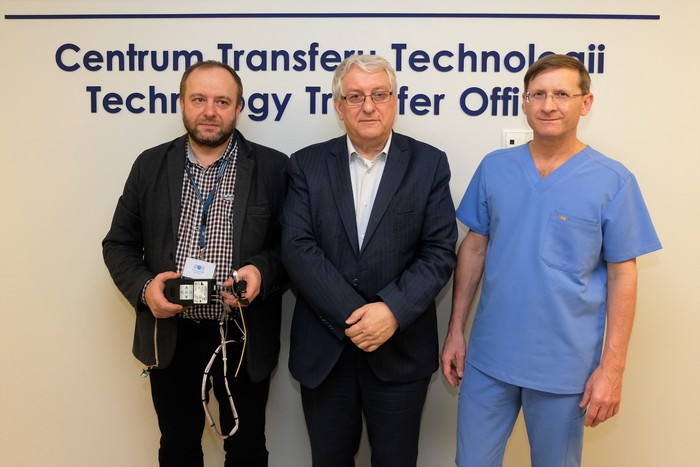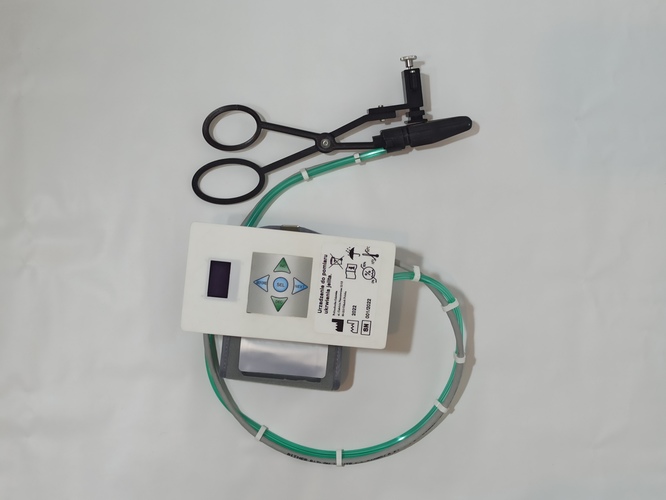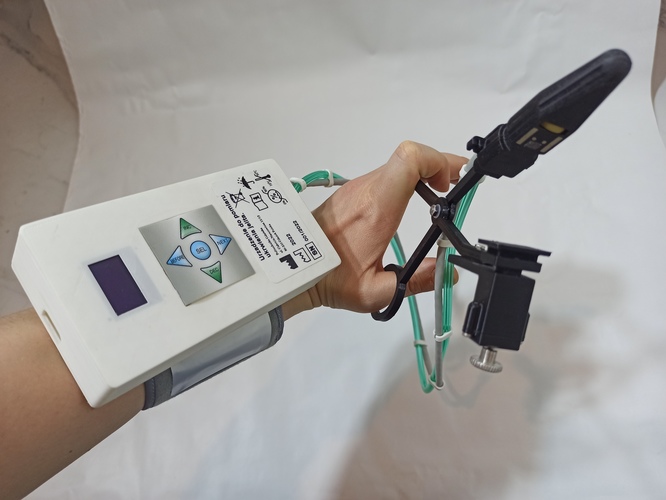An innovative device for the assessment of blood supply to the gastrointestinal tract
24.02.2022
A team of scientists from the Medical University of Gdańsk and the Gdańsk University of Technology under the supervision of Prof. Jacek Zieliński from the Department of Surgical Oncology of the MUG has developed a prototype of an innovative device for intraoperative blood flow testing in the organs of the gastrointestinal tract. The proposed solution may significantly increase the effectiveness of the performed surgical procedures by reducing the number of potential postoperative complications. It was carried out as part of the project “Method and device for the combined assessment of blood supply to the organs of the gastrointestinal tract”, headed by Prof. Jacek Zieliński from the MUG. The funds allocated for this purpose in the amount of 100 000 PLN come entirely from the Innovation Incubator 4.0 program, which is financed from European funds as part of the non-competitive project “Support for scientific research management and commercialization of R&D results in research units and enterprises”. It is implemented under the Intelligent Development Operational Program 2014-2020 by the MUG’s Technology Transfer Office.

From the left: Adam Bujnowski, Eng.D., Prof. Jerzy Wtorek, Prof. Jacek Zieliński, photo by Marcin Stolarek/MUG
– In surgery, the blood supply to the tissues is the basic condition that guarantees proper wound healing. This principle applies to all types of operations, but the proper blood supply to the tissues is of particular importance in gastrointestinal surgery and during extensive operations in other parts of the body. In the case of the gastrointestinal tract, the blood circulation disorder is closely related to the level of resection, starting from the esophagus and ending with the distal area, i.e. the rectum. – says project’s supervisor Prof. Jacek Zieliński from the Department of Surgical Oncology of the MUG.
In practice, the organs at high risk of ischemia are: the esophagus, which is anastomosed with the stomach, small intestine or large intestine. Another place in the digestive tract where blood supply is disturbed is the rectal stump and the end of the small or large intestine used for anastomosis or stoma. After resection of the gastrointestinal tract, one of the most important conditions for proper healing is the fixation of tissues with proper blood supply, i.e. with proper blood supply. In the case of an incorrect assessment of the blood supply to tissues and the method of their anastomosis, e.g. in the intestines, postoperative complications may appear, which in their mildest stage require corrective surgery, and at worst may lead to serious consequences, including sepsis or death of the patient. According to the literature data, the leakage of anastomosis is estimated in the range of 3-30% of cases.
Current methods of blood supply assessment
At present, the blood supply to the tissues, including the gastrointestinal tract, is mainly assessed based on the experience of the surgeon. In practice, the blood supply to the examined part of the digestive tract is assessed using two techniques: (a) macroscopic, i.e. visual, (b) palpation (tactile). The technique using indocyanine green, known as the fluorescent method, is used as an auxiliary method of blood supply.
– The idea of creating the device was born during my daily work at the Division of Surgical Oncology of the University Clinical Centre. All of the commonly used methods of tissue blood supply assessment provide information with a high degree of subjectivity, which may increase the risk of surgery failure. I decided that it is worth making the effort to create a method and device that, on the one hand, would contribute to increasing the level of safety of the operated patients, and, on the other hand, would also increase the comfort of the surgeon’s work. – explains Prof. Jacek Zieliński.

A prototype of a device for the combined assessment of the blood supply to the digestive tract organs – a probe with a gripper with an electronic control unit, photo by Marek Dudek
Professor Jacek Zieliński, in consultation with scientists from the Department of Biomedical Engineering, Gdańsk University of Technology, created an interdisciplinary team whose task was to find an effective solution. Thanks to the synergy resulting from the application of practical clinical knowledge with bioengineering and the use of several measurement methods, it was possible to create the world’s first system for the combined assessment of gastrointestinal blood flow. The set consists of a probe equipped with a number of measuring sensors and an electronic control unit. During the surgical procedure, the probe of the device inserted into the intestine, for example, provides the operating team with information on the degree of oxygen saturation of the tissues. This makes it easier to perform anastomosis ensuring proper wound healing.
– The problem is quite complex and demanding – explains Prof. Jerzy Wtorek, Coordinator of the BioTechMed Centre of the Gdańsk University of Technology. – First, it is about measuring very small volumes that vary in structure and properties of tissues. The volume of blood, therefore, is also small. Moreover, the evaluation is performed after the resection of a part of the tissue, i.e. the blood system is haemodynamically “open” and thus the physiological range of the parameters describing the blood flow cannot be assumed during the measurements. Hence, the method used to assess the blood supply is relatively complex and, depending on the situation, multi-stage. In the event that the measurements are subject to high uncertainty, subsequent measurements are automatically carried out, and their evaluation is carried out using more advanced analysis methods. However, despite the relatively complex measurement procedure and advanced processing techniques, we managed to propose a solution that does not absorb the surgeon and – which is also important – the time of the assessment is acceptable from the point of view of the surgical procedure. The great advantage of the method is also the possibility, if necessary, of multiple measurements on the same patient, which has practically no effect on the duration of the procedure. In summary, we developed a multimodal device and appropriate measurement procedures to assess the blood supply and viability of the anastomosed tissues. It was possible thanks to controlling the dynamic changes in blood volume in the examined tissue. The method does not burden the surgeon with additional and complex activities and we hope that, after conducting experimental tests, the obtained results will be helpful in making decisions by the surgeon, also thanks to the fact that their interpretation will be unambiguous.

A prototype of a device for the combined assessment of the blood supply to the digestive tract organs – a probe with a gripper with an electronic control unit, photo by Marek Dudek
Benefits of using the device in operational conditions
The developed set has a number of advantages, the most important of which are the small size, weight and handiness of the device. As a result, the operation of the device is comfortable and does not extend the duration of the surgical procedure, and its use is safe for patients. Other important functionalities include the ability to send data via radio in the Bluetooth standard. Thanks to this, the data can be analyzed using more computing power than that in the device used, and presented on a screen larger than that in the prototype. Additionally, it is possible to archive the records, which will enable their statistical analysis and further development of blood flow assessment algorithms.
The introduction of the device for use during surgical procedures may significantly reduce the percentage of postoperative complications, including those requiring corrective procedures. Thanks to this, it would be possible to reduce the costs of treatment by reducing the number of reoperations and shortening the treatment time of patients, which would also translate into an increase in the comfort of their treatment.
– The tissue perfusion project was developed because there was an unmet clinical need. The main goal of the project was to create a solution – a device that will enable the surgeon to objectively determine the blood supply to the anastomosed tissues based on measurements. From the beginning, the study had key elements for the implementation of a project with implementation potential – it was aimed at designing a solution that meets certain parameters with a defined recipient and payer – adds Katarzyna Waligóra-Borek, Ph.D., Acting Director of the MUG’s Technology Transfer Office. – The most important, however, from the point of view of the implementation of the project assumptions, is the team. In this case, the interdisciplinary specialists include: Prof. Jacek Zieliński – project manager, oncologist surgeon and specialists in the design and construction of medical devices Prof Jerzy Wtorek and Adam Bujnowski, Eng.D. – specialists in the field of biomedical engineering. It is an excellent example of cooperation between the universities of the Medical University of Gdańsk and the Gdańsk University of Technology. It is also worth mentioning here that this is another project developed by this team.

A prototype of a device for the combined assessment of the blood supply to the digestive tract organs – a probe with a gripper with an electronic control unit, photo by Marek Dudek
The researcher’s cooperation in the field of commercialization with the Technology Transfer Office of the MUG
Professor Zieliński’s cooperation with the Technology Transfer Office of the MUG (TTO) began in 2017. As part of the first edition of the Innovation Incubator + program implemented by TTO, two projects were completed, completed with pre-implementation works. The current project is implemented under the Innovation Incubator 4.0 program financed by European funds as part of the non-competitive project “Support for scientific research management and commercialization of R&D results in research units and enterprises”, implemented under the Intelligent Development Operational Program 2014-2020 by the Technology Transfer Office of the MUG technology. It concerns research on the blood supply to the gastrointestinal tract in terms of methods of preventing anastomotic leak in esophageal, stomach and large intestine surgeries.
The Technology Transfer Office of the MUG also provided comprehensive care in the field of intellectual property rights protection, under which the developed invention was submitted for protection in the Patent Office of the Republic of Poland. In 2021, two independent prior art studies were carried out, indicating that there is currently no known medical device whose operating principle would be similar to the developed invention. Therefore, a decision was made to submit the invention for international protection under the PCT procedure.
Despite the success in developing the prototype of the device, a team of scientists led by prof. Jacek Zieliński consistently carries out development works of the invention in accordance with the established strategy. Its aim is to increase the technological readiness of the device enabling its use on the market. The invention will now be tested in medical experiments planned on pig models. In the next stages of development, clinical trials and certification of the device are planned. Based on the conclusions drawn from the actions taken, an optimal business model for the implementation of the device will be developed and the final decision will be made regarding the choice of the form of commercialization.
Archives
- Academic Year 2024/2025
- Academic Year 2023/2024
- Academic Year 2022/2023
- Academic Year 2021/2022
- Academic Year 2020/2021
- Academic Year 2019/2020
- Academic Year 2018/2019
- Academic Year 2017/2018
- Academic Year 2016/2017
- Academic Year 2015/2016
- Academic Year 2014/2015
- Academic Year 2013/2014
- Academic Year 2012/2013